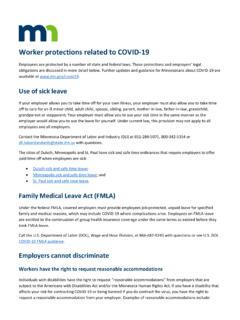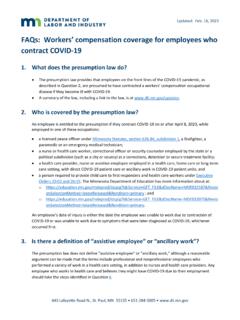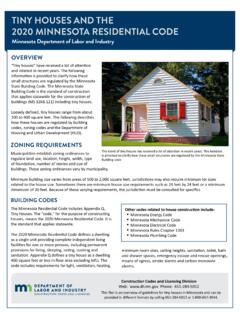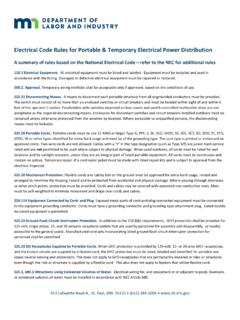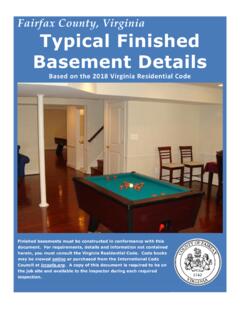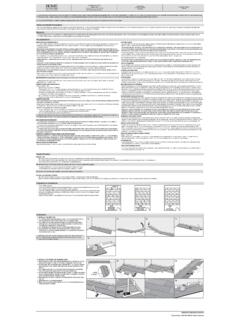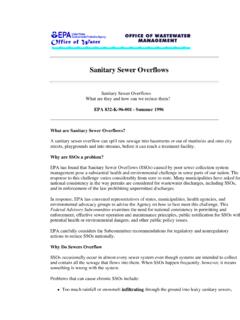Transcription of 2020 NEC Changes
1 Updated 20210601 2020 nec changes Important: Please refer to the 2020 National Electrical Code for detailed information 1. (A) GFCI Protection for Personnel: Dwelling Units The Changes in (A) will result in all 125 volt through 250 volt receptacles installed at dwelling units supplied by single phase branch circuits rated 150 volts or less to ground be provided with ground fault circuit interrupter (GFCI) protection for personnel. During the 2020 NEC cycle it was substantiated that 250 volt receptacle outlets present similar shock hazards as 125 volt receptacle outlets.
2 This change will impact the typical 240 volt receptacle outlets for cord and plug connected dryers, ranges, ovens or similar appliances. This new addition of 250 volt receptacles, and the removal of any ampere limitation, will require GFCI protection for commonly used receptacle outlets in the specified areas of (A)(1) through (A)(11): Bathrooms, Garages and Accessory Buildings, Outdoors, Crawl Spaces, Basements, Kitchens, Sinks, Boathouses, Bathtubs and Shower Stalls, Laundry Areas, Indoor Damp and Wet Locations. Also, (A)(2) for basements previously only required GFCI protection in unfinished areas; (A)(2) requires all receptacle outlets in basements (area below grade level) to be GFCI protected, regardless if the basement is finished or unfinished.
3 During the 2020 NEC code cycle it was substantiated that conductive floor surfaces prone to damp, wet or flooded conditions may exist in both finished and unfinished basements. The potential for electrical hazards and risk of a shock hazard exists regardless of unfinished or finished surfaces. 2. (B) Ground-Fault Circuit-Interrupter Protection for Personnel: Other than Dwelling Units In (B)(2), a change to the way kitchen areas are viewed will further expand the requirements for ground fault protection for personnel.
4 All 125 volt through 250 volt receptacles supplied by single phase branch circuits rated 150 volts or less to ground, 50 amps or less, and all receptacles supplied by three phase branch circuits rated 150 volts or less to ground, 100 amps or less, shall have ground fault circuit interrupter protection when installed in kitchens or areas with a sink and permanent provisions for either food preparation or cooking. As in other editions of the NEC, the kitchen area must include a sink; however, GFCI protection will be required where employees either cook or prepare food to serve customers.
5 This section would apply to: Coffee shops that serve food, candy, ice cream shops, and sandwich shops, etc. where the selling of the products and business services are regulated by the Department of Health or others. Updated 20210601 This section would not apply to: Convenience stores and other similar locations where customers are serving themselves or purchasing pre packaged food for consumption. These facilities would generally not be considered permanent food preparation or cooking areas. Reheating or heating prepared foods or keeping cooked foods warm or hot with portable appliances will not be considered permanent provisions for cooking.
6 However, if there is a sink in close proximity of the various appliances, those receptacles mentioned above and within six feet of the top inside edge of the sink would require ground fault circuit interrupter protection per (B)(5). 3. (F) Ground-Fault Circuit-Interrupter Protection for Personnel: Outdoor Outlets GFCI protection is required on dwelling unit outdoor outlets* supplied by single phase branch circuits rated 150 volts or less to ground, and 50 amperes or less. NEC (F) is only applicable to readily accessible outdoor equipment outlets.
7 The intent of the requirement is to protect individuals who may come into contact with outdoor equipment that is likely to become energized. This change will mostly impact outdoor heat pumps, air conditioning units and similar equipment. There is an exception that excludes outdoor lighting outlets from having to be GFCI protected. (F) is not applicable to: Outdoor outlets that are not readily accessible such as a submersible well pumps, sewer lift pumps, load management controllers, surge protection devices, or similar equipment.
8 Existing outdoor outlets and the supplied equipment: o Replacement or repair of existing outdoor readily accessible electrical equipment utilizing the same feeder or branch circuit conductors. o Replacement or repair of the existing outdoor disconnect, or the replacement of the electrical conductors and raceway (whip) from the disconnect to the electrical equipment. Note: 240 volt, single phase, GFCI breakers must have a neutral extended to the circuit breaker for the breaker to operate properly. The NEC has separate rules for fixed outdoor electric deicing and snow melting equipment, and similarly for electric heat tracing equipment.
9 *Recall that NEC Article 100 defines an Outlet as a point on the wiring system at which current is taken to supply utilization equipment. The term outlet is often misused to refer to receptacles. Receptacle outlets are only one type of outlet. Other types of outlets include lighting outlets, appliance outlets, smoke alarm outlets, equipment outlets and so on. Updated 20210601 4. (C)(4) Garage Branch Circuits This rule was clarified to emphasize that the required 120 volt, 20 ampere branch circuit shall be installed to supply receptacle outlets required by (G)(1) for attached garages and in detached garages with electric power.
10 In other words, garage receptacle outlets that are not required by (G)(1) do not have to be supplied by this dedicated 120 volt, 20 ampere branch circuit, or even be supplied by a 20 ampere rated branch circuit. Additional convenience receptacle outlets could be supplied by either a 15 ampere or 20 ampere rated branch circuit. Also, there is no prohibition to extend the required 20 ampere branch circuit to other receptacles in the garage (above feet). The required 20 ampere branch circuit shall have no other outlets (such as lighting outlets).





